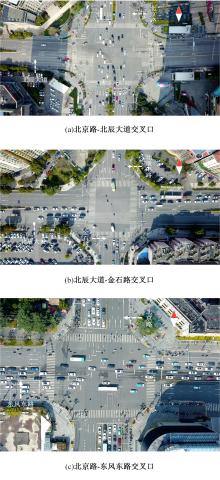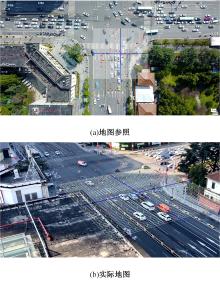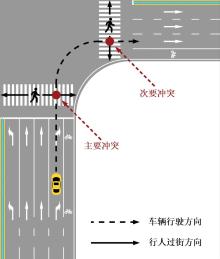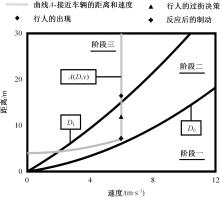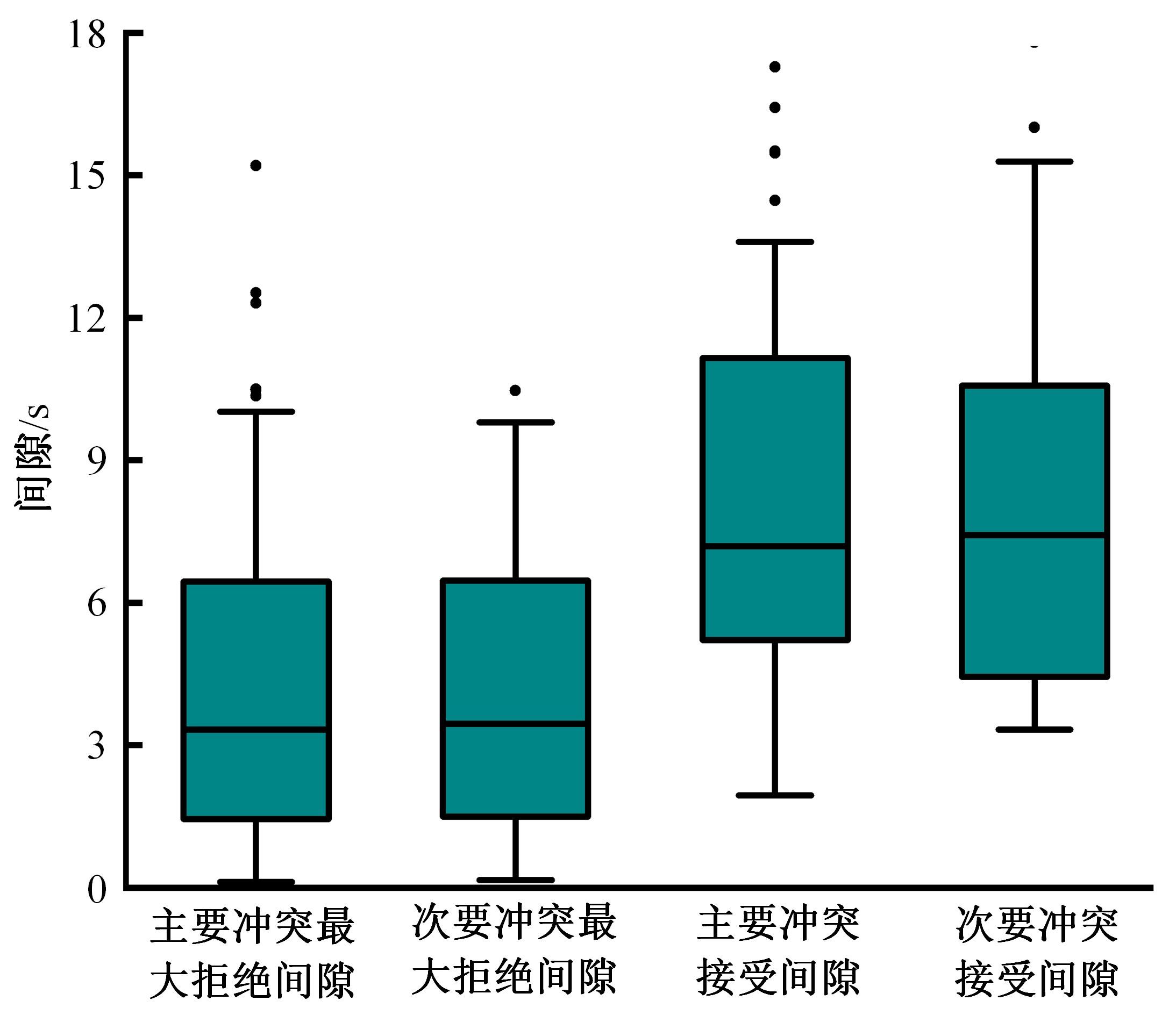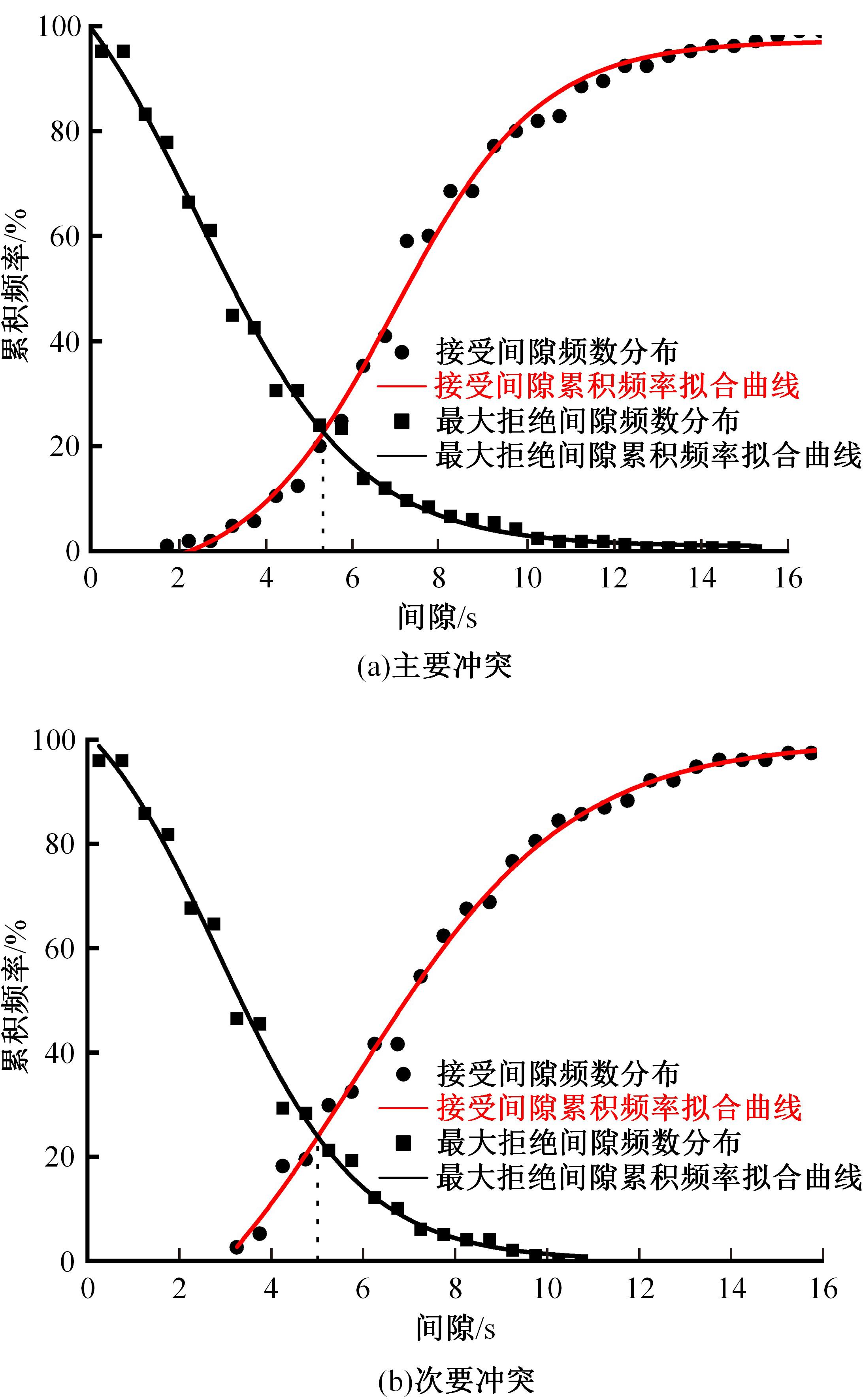吉林大学学报(工学版) ›› 2024, Vol. 54 ›› Issue (7): 1903-1912.doi: 10.13229/j.cnki.jdxbgxb.20221108
• 交通运输工程·土木工程 • 上一篇
考虑右转车二次冲突的信号交叉口行人过街安全评价方法
- 1.东北林业大学 交通学院,哈尔滨 150040
2.吉林建筑大学 交通科学与工程学院,长春 130118
Safety evaluation method for pedestrians crossing street at signalized intersection considering secondary conflict of right-turn vehicles
Guo-zhu CHENG1( ),Lin SHENG1,Hao-yu WANG1,Tian-jun FENG2
),Lin SHENG1,Hao-yu WANG1,Tian-jun FENG2
- 1.School of Traffic and Transportation,Northeast Forestry University,Harbin 150040,China
2.School of Transportation Science and Engineering,Jilin University of Architecture,Changchun 130118,China
摘要:
为研究信号交叉口右转车二次冲突过程中行人过街的安全性,选择云南省昆明市3个信号交叉口作为研究对象,利用交通冲突分析软件T-Analyst获取车辆轨迹数据和交通冲突数据。采用多角度的安全评价方法:基于DV框架判断人-车冲突的初始情况;采用交通冲突指标PETS和PETH、最大拒绝间隙与接受间隙、平均过街车速分析行人过街的安全性。结果表明:相比于次要冲突,主要冲突中行人面对的冲突初始情况更加危险,行人选择有风险过街的频率也更高。车辆的过街行为、交通冲突指标PETS和PETH、最大拒绝间隙、接受间隙、临界间隙等指标在右转车二次冲突中没有明显区别,但次要冲突的平均过街车速明显高于主要冲突的平均过街车速,行人过街的潜在风险在次要冲突处更高。
中图分类号:
- U491.7
| 1 | Zhu D, Sze N N, Bai L. Roles of personal and environmental factors in the red light running propensity of pedestrian: case study at the urban crosswalks[J]. Transportation Research Part F: Traffic Psychology and Behaviour, 2021, 76: 47-58. |
| 2 | World Health Organization. Global status report on road safety 2018: summary[R]. Geneva:World Health Organization, 2018. |
| 3 | Fu T, Hu W, Miranda-Moreno L, et al. Investigating secondary pedestrian-vehicle interactions at non-signalized intersections using vision-based trajectory data[J]. Transportation Research Part C: Emerging Technologies, 2019, 105: 222-240. |
| 4 | 程国柱, 盛林, 赵浩, 等. 基于危险度分析的信号交叉口专用相位设置条件[J]. 吉林大学学报: 工学版,2023, 53(7): 1962-1969. |
| Cheng Guo-zhu, Sheng Lin, Zhao Hao, et al. Exclusive phase setting condition of signalized intersection based on risk analysis[J]. Journal of Jilin University (Engineering and Technology Edition), 2023, 53(7):1962-1969. | |
| 5 | Jackson S, Miranda-Moreno L F, St-Aubin P, et al. Flexible, mobile video camera system and open source video analysis software for road safety and behavioral analysis[J]. Transportation Research Record, 2013, 2365(1): 90-98. |
| 6 | St-Aubin P, Saunier N, Miranda-Moreno L. Large-scale automated proactive road safety analysis using video data[J]. Transportation Research Part C: Emerging Technologies, 2015, 58: 363-379. |
| 7 | Laureshyn A, De Ceunynck T, Karlsson C, et al. In search of the severity dimension of traffic events: extended Delta-V as a traffic conflict indicator[J]. Accident Analysis & Prevention, 2017, 98:46-56. |
| 8 | Fu T, Miranda-Moreno L, Saunier N. A novel framework to evaluate pedestrian safety at non-signalized locations[J]. Accident Analysis & Prevention, 2018, 111: 23-33. |
| 9 | Jiang C, Qiu R, Fu T, et al. Impact of right-turn channelization on pedestrian safety at signalized intersections[J]. Accident Analysis & Prevention, 2020, 136: No.105399. |
| 10 | Wei D, Xu H, Kumfer W, et al. Vehicular traffic capacity at unsignalized crosswalks with probabilistic yielding behavior[J]. Transportation Research Record, 2015, 2483(1): 80-90. |
| 11 | Zhang C, Zhou B, Qiu T Z, et al. Pedestrian crossing behaviors at uncontrolled multi-lane mid-block crosswalks in developing world[J]. Journal of Safety Research, 2018, 64: 145-154. |
| 12 | 中华人民共和国全国人民代表大会常务委员会. 中华人民共和国道路交通安全法[J]. 中华人民共和国全国人民代表大会常务委员会公报, 2008(1): 32-45. |
| The Standing Committee of the National People's Congress of the People's Republic of China. Road traffic safety law of the People's Republic of China[J]. Gazette of the Standing Committee of the National People's Congress of the People's Republic of China, 2008(1): 32-45. | |
| 13 | Zhang Y, Fricker J D. Incorporating conflict risks in pedestrian-motorist interactions: a game theoretical approach[J]. Accident Analysis & Prevention, 2021, 159: No. 106254. |
| 14 | Shaon M R R, Schneider R J, Qin X, et al. Exploration of pedestrian assertiveness and its association with driver yielding behavior at uncontrolled crosswalks[J]. Transportation Research Record, 2018, 2672(35): 69-78. |
| 15 | Wang Y, Su Q, Wang C, et al. Investigating yielding behavior of heterogeneous vehicles at a semi-controlled crosswalk[J]. Accident Analysis & Prevention, 2021, 161: No.106381. |
| 16 | Zhang Y, Fricker J D. Multi-state semi-Markov modeling of recurrent events: estimating driver waiting time at semi-controlled crosswalks[J]. Analytic Methods in Accident Research, 2020, 28: No.100131. |
| 17 | Sołowczuk A, Kacprzak D. Identification of the determinants of the effectiveness of on-road chicanes in transition zones to villages subject to a 70 km/h speed limit[J]. Energies, 2020, 13(20): No.5244. |
| 18 | Varhelyi A. Drivers' speed behaviour at a zebra crossing: a case study[J]. Accident Analysis & Prevention, 1998, 30(6): 731-743. |
| 19 | Zhang C, Zhou B, Chen G, et al. Quantitative analysis of pedestrian safety at uncontrolled multi-lane mid-block crosswalks in China[J]. Accident Analysis & Prevention, 2017, 108: 19-26. |
| 20 | Transportation Research Board. Highway Capacity Manual[M]. Washington DC: National Research Council,2010. |
| 21 | Pawar D S, Patil G R. Critical gap estimation for pedestrians at uncontrolled mid-block crossings on high-speed arterials[J]. Safety Science, 2016, 86: 295-303. |
| 22 | 马万经, 叶新晨, 廖大彬, 等. 停车让行交叉口机动车接受间隙和拒绝间隙分布特征[J]. 中国公路学报, 2015, 28(4): 86-93. |
| Ma Wan-jing, Ye Xin-chen, Liao Da-bin, et al. Distribution characteristics of accepted gap and rejected gap for vehicles crossing stop-controlled intersections[J]. China Journal of Highway and Transport, 2015, 28(4): 86-93. | |
| 23 | Brilon W, Koenig R, Troutbeck R J. Useful estimation procedures for critical gaps[J]. Transportation Research Part A: Policy and Practice, 1999, 33(3/4): 161-186. |
| [1] | 秦雅琴,钱正富,谢济铭. 协同换道避障模型和轨迹数据驱动的车辆协同避障策略[J]. 吉林大学学报(工学版), 2024, 54(5): 1311-1322. |
| [2] | 张明业,杨敏,黎彧,黄世玉,李清韵. 考虑有序充电策略的多车型电动公交调度优化[J]. 吉林大学学报(工学版), 2024, 54(5): 1293-1301. |
| [3] | 马潇驰,陆建. 基于基因表达式编程的高架道路事故实时预测[J]. 吉林大学学报(工学版), 2024, 54(3): 719-726. |
| [4] | 严利鑫,冯进培,郭军华,龚毅轲. 不同险态情景下共驾型智能车辆接管行为特征分析[J]. 吉林大学学报(工学版), 2024, 54(3): 683-691. |
| [5] | 曲大义,张可琨,顾原,王韬,宋慧,戴守晨. 自动驾驶车辆换道决策行为分析及分子动力学建模[J]. 吉林大学学报(工学版), 2024, 54(3): 700-710. |
| [6] | 涂辉招,王万锦,乔鹏,郭静秋,鹿畅,吴海飞. 自动驾驶卡车路测安全员接管干预行为解析[J]. 吉林大学学报(工学版), 2024, 54(3): 727-740. |
| [7] | 张健,李青扬,李丹,姜夏,雷艳红,季亚平. 基于深度强化学习的自动驾驶车辆专用道汇入引导[J]. 吉林大学学报(工学版), 2023, 53(9): 2508-2518. |
| [8] | 郑植,袁佩,金轩慧,魏思斯,耿波. 桥墩复合材料柔性防撞护舷试验[J]. 吉林大学学报(工学版), 2023, 53(9): 2581-2590. |
| [9] | 李建华,王泽鼎. 考虑路径耗时的城市汽车分布式充电桩选点规划[J]. 吉林大学学报(工学版), 2023, 53(8): 2298-2303. |
| [10] | 李洪涛,王琳虹,李俊达. 公路交叉口照明和限速对视觉搜索能力的影响[J]. 吉林大学学报(工学版), 2023, 53(8): 2287-2297. |
| [11] | 巫威眺,曾坤,周伟,李鹏,靳文舟. 基于多源数据和响应面优化的公交客流预测深度学习方法[J]. 吉林大学学报(工学版), 2023, 53(7): 2001-2015. |
| [12] | 程国柱,盛林,赵浩,冯天军. 基于危险度分析的信号交叉口专用相位设置条件[J]. 吉林大学学报(工学版), 2023, 53(7): 1962-1969. |
| [13] | 何永明,陈世升,冯佳,万亚楠. 基于高精地图的超高速公路虚拟轨道系统[J]. 吉林大学学报(工学版), 2023, 53(7): 2016-2028. |
| [14] | 薛志佳,王召阳,张久鹏,晏长根,许子凯,张英立,黄晓明,马涛. 泥石流作用下道路结构韧性分析及提升[J]. 吉林大学学报(工学版), 2023, 53(6): 1773-1781. |
| [15] | 刘振亮,赵存宝,吴云鹏,马迷娜,马龙双. 数据驱动的公路桥梁网络全寿命抗震韧性评估[J]. 吉林大学学报(工学版), 2023, 53(6): 1695-1701. |
|
||
